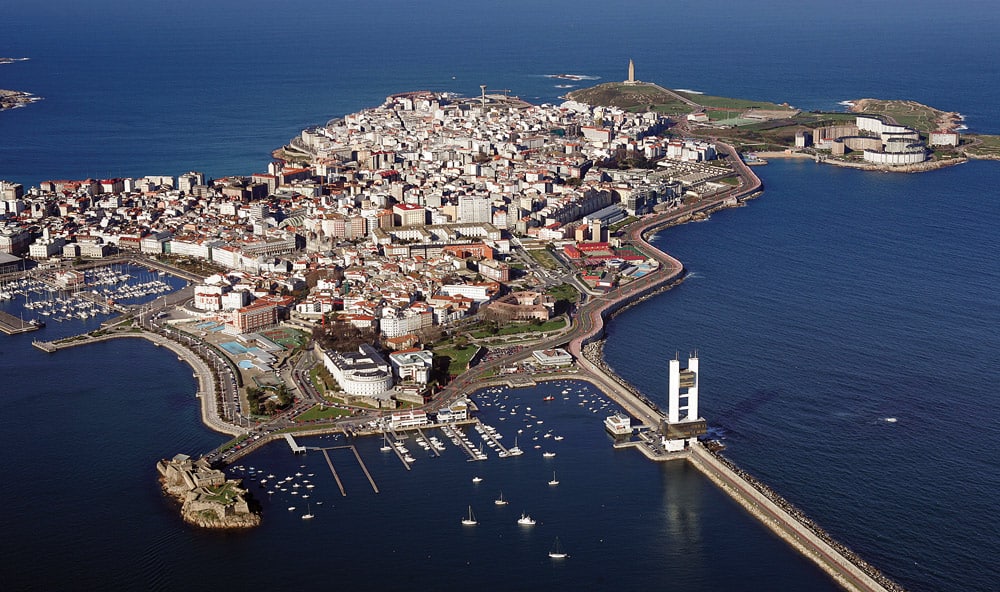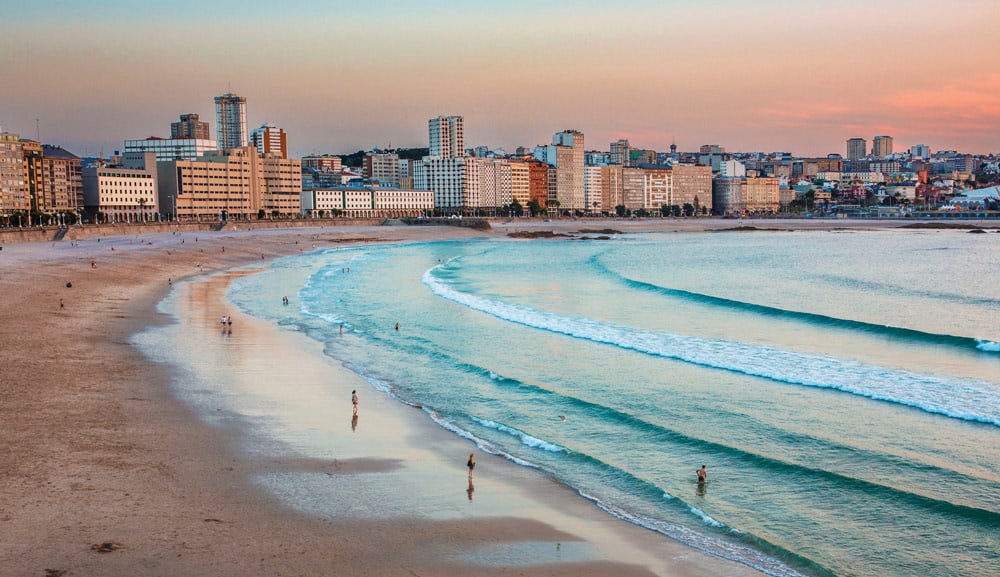A Coruna is steeped in history and legends, writes Michael Fewer as he discovers many Irish connections with the Spanish region of Galicia.
What have the fashion range of Zara, Donal Cam O’Sullivan Beare and Picasso got in common? Well, the founder of Zara, Amancia Ortega, one of the world’s richest men, opened his first outlet in the north coastal Galician city of A Coruna, where Donal Cam lived for five years after the Battle of Kinsale, and it was here that Picasso lived as a child and had his first art exhibition at the tender age of 12.
For long in the shadow of the famous Galician pilgrimage city of Santiago de Compostela, Santiago’s neighbour to the north, A Coruna, which well deserves to be better known, is a beautiful sea-girded city whose history goes back even further than that of Santiago, and today is a fascinating modern destination with all the amenities and attractions the discerning tourist could desire.
The original settlement was established by a Celtic tribe in the third century BC, and the natural harbour here attracted the Romans as they expanded their empire west, so they moved in and renamed the town Brigantium. That ambitious Roman coloniser, Julius Caesar, who those of us who did Latin in school know well, was here in 62 BC with a naval fleet of a hundred triremes, those great galley warships with three banks of oars operated by slaves. Intent on expanding trade with the Atlantic lands and islands further north, he was seeking metals for the expanding Roman economy.
Over the succeeding centuries A Coruna had to deal with attacks by the Moors, the Vikings and eventually the Normans, but saw the beginnings of prosperity in the 13th century, when it was granted the title ‘City’ by John II of Castile. In recent times, and particularly since the mid 20th century, the city has spread inland and along the coast, its population increasing from 44,000 in 1900 to 250,000 a 100 years later.
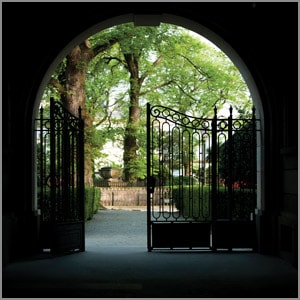
Jardin San Carlos
Apart from story of the Milesians, who in legend departed from here to invade Ireland, Irish connections with A Coruna are many. Irish pilgrims to Santiago landed here after perilous voyages from Waterford, Kinsale and Dingle. James Rice, 11 times Mayor of Waterford in the 15th century, was either very sinful or a plucky man: he made the pilgrimage twice.
For a while the church was concerned about the opportunities for pilgrims – removed from the stabilising influences of home and community, to indulge in sexual licence and other sinful behaviour – and considered banning pilgrimages altogether. After the Flight of the Earls, 5,000 Irish soldiers kept the taverns here busy for a while, and the west Cork Chieftain Donal Cam O’Sullivan Beare enjoyed five years in residence in the city with his extended family and retainers, bankrolled by the Spanish king. The family would have felt at home attending mass in the church of Santa Maria del Campo in the old town, its Romanesque architecture is so similar to churches of the period in Ireland.
A Coruna is a place of comings and goings. Late in the 15th century Katherine of Arragon left from here on a voyage to England and her marriage to Arthur, Henry VIII’s brother, followed eventually by marriage to Henry himself. Nearly a century later, the ill-fated Spanish Armada sheltered from storms here, before sailing north into disaster. Early in the 17th century Red Hugh O’Donnell, Prince of Tyrconnell, arrived here in the wake of the Battle of Kinsale, looking for more money and arms from the king.
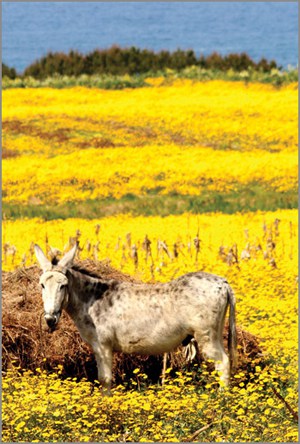 MODEST MUSEUMS
MODEST MUSEUMS
At the Jardin de San Carlos you will find the tomb of Sir John Moore, hero of the Peninsular Wars. He led an army of 20,000 Scots, Welsh, Irish and English soldiers in a great Dunkirk-like escape from Napoleon in 1808, but was killed holding them back while the army poured on board Royal Naval ships in the harbour. The modest tomb, in a quiet and peaceful garden, is impressive, and they say the ghost of his lover visits it on the anniversary of his death.
The ill-fated Spanish Armada sheltered from storms here, before sailing north into disaster
A Coruna has a number of interesting museums, none so big as to be daunting. Worth seeing is the Domus Museum, an impressive place designed by the Japanese architect Arata Isozaki, and claimed to be first ‘interactive’ museum in the world devoted to the human being. There was a fascinating exhibition when I was there about ‘personalised medicine’, the theory being that we should only be medically treated in keeping with our unique individual genetic profile. The glass cube-like National Museum of Science and Technology is packed full of scientific instruments, tools and vehicles from the 16th century onwards, including the huge front section of a Jumbo jet.
For those interested in history and archaeology, the Museo Arqueolóxico e Histórico can be found in the Castillo de San Anton, a 16th century fortress in the port. It houses a rich collection of exhibits ranging from the pre-history of A Coruna to the famous attack on the city by Sir Francis Drake. Here you will find another Irish connection: among the treasures on display is a gold helmet dating from the Bronze Age similar to ‘helmets’ that have been found in Ireland.
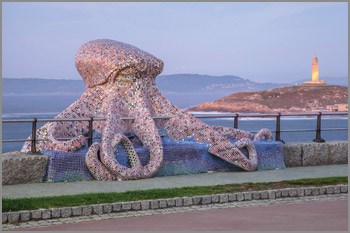
Promenade octypus
A Coruna not only has a commercial port, a fishing port and a yachting marina, but on the other side of the narrow isthmus it has a large crescent beach, Playa de Riazor, and when the waves are good, you can surf a few hundred metres from the centre of the old town. Look out for the marvellous and appropriate sculpture of a large octopus on the promenade.
Pablo Picasso was nine when he came with his family to live A Coruna where his father was appointed a teacher at the Provincial School of Fine Arts. Look out for Number 20 on A Coruna’s most fashionable street, Calle Real, where he had his first exhibition, when he was aged 12. He quickly developed his skill at drawing in charcoal and ink, using local people and fishermen as his models and he was soon showing the attributes of a child prodigy. The local newspaper of the time suggested the boy faced ‘greatness and glory’.
Perhaps the most spectacular building in A Coruna is the Tower of Hercules, a place that is wrapped in legends, one of which tells of the island of Ireland been spied from its top by a Milesian prince. Built by the Romans in the 1st century AD as a lighthouse, it still performs its duty 2,000 years later. It is open to the public and is well worth a visit.
FRUITS OF THE SEA
A Coruna is becoming a gourmet’s mecca, particularly for those foodies who love seafood in all its forms. You can watch the fishing boats leave the harbour in the morning, and you know what they catch out on the rich deeps of the Bay of Biscay will be superbly served up that very evening on a table only a few hundred metres from the port. Pulpo (octopus) is ubiquitous in A Coruna, served in every way one can imagine, with the choice of a myriad of sauces. Be prepared: the mixed seafood platters are often huge.
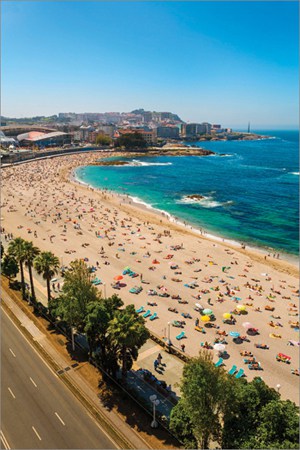
Riazor beach
Look out for the Pulperia O Fiuza bar and restaurant near the Tower of Hercules. You’ll find it in Avenida Navarra 33, Baio, A Coruna. It’s a busy place with rustic wooden tables and barrels, and a favourite of the locals, which is always a good sign. You can drink wine in the traditional Galician way, in white porcelain bowls, and eat the best of octopus with all its accompaniments. There is a very noisy, festive atmosphere when the local team, Real Club Deportivo de la Coruna, are playing a televised match.
Irish pilgrims to Santiago landed here after perilous voyages from Waterford, Kinsale and Dingle
At the other end of the scale, and for more elaborate dining, try the Seafood Restaurant Augamar, located at the yachting marina and with fabulous views out over the marina and the Ria de Coruna.
I was surprised to find that they even serve Argentinian wines. A wide range of seafood is served, including cod, monkfish and scallops. I recommend you try their monkfish, with a well-chilled Albarino white of Galicia, and a dessert of arroz con leche; it’s a rice pudding the likes of which your mother never served. You’ll find Augamar on Promenade Mayor Francisco Vázquez.
DAY TRIPPERS
The coastline west from A Coruna is my favourite part of rural Galicia, and well worth exploring by car. The quiet country roads are rarely busy, and a pleasant hour and a half will take you through the beautiful Galician countryside to Finisterre, the end of the world, and the Costa da Morte, known for the many ships that have been wrecked on its rocky granite shore. Some pilgrims to Santiago walk the extra 90km to swim in the sea at Finisterre and sometimes to burn their clothes, a true end to their pilgrimage.
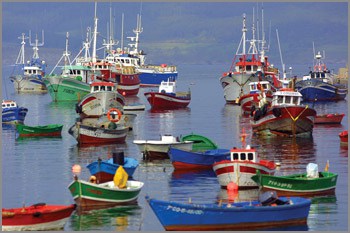 It is said that the Phoenicians used the bay here in the Bronze Age as a base for exploring the islands of Britain and Ireland, seeking copper and tin. Today, Finisterre is a major fishing port, so time your arrival so that you can have lunch in one of the restaurant-bars overlooking the port. The sardines were my favourite, grilled and salted on a barbecue and served with bread and a chilled white wine: simple but perfect.
It is said that the Phoenicians used the bay here in the Bronze Age as a base for exploring the islands of Britain and Ireland, seeking copper and tin. Today, Finisterre is a major fishing port, so time your arrival so that you can have lunch in one of the restaurant-bars overlooking the port. The sardines were my favourite, grilled and salted on a barbecue and served with bread and a chilled white wine: simple but perfect.
It is well worth returning to A Coruna by way of the coast, through the least spoilt part of Galicia. Pause a while at the quiet and quaint village of Lires, where ancient houses rub shoulders with spanking new villas, and you can see good examples, by the roadside, of the iconic Galician horreo. It’s a kind of stone-built grain store, sometimes looking like a little church, perched on mushroom-shaped stilts to prevent animals from getting at the goodies inside.
From the village take a narrow road following the River Lires through beautiful shady woodland to the Atlantic, where it flows into the sea between the most idyllic beaches imaginable. Pristine and often deserted, if you like to swim you will not be able to resist the waters here. On the other side of the river, large flocks of seabirds gather when the tide is out, including dozens of cormorants who’s wings are often comically outstretched, drying in the sun.
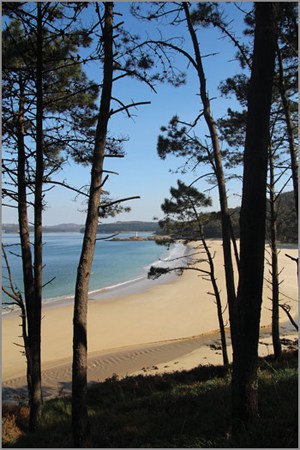 Farther north is the town of Muxia (pronounced moo-shia), where on the rocky shore beyond the harbour, there are a series of large and strange-shaped glacial erratics that are said to be the remains of a boat which delivered the Mother of God to this coast to assist St James in evangelising the people.
Farther north is the town of Muxia (pronounced moo-shia), where on the rocky shore beyond the harbour, there are a series of large and strange-shaped glacial erratics that are said to be the remains of a boat which delivered the Mother of God to this coast to assist St James in evangelising the people.
… a pleasant hour and a half will take you through the beautiful Galician countryside to Finisterre, the end of the world, and the Costa da Morte
One slab of granite, called Pedra dos Namorados is a lover’s stone where couples come to pledge their love. Crawling nine times under another great slab is said to cure backache. We tried it, but actually got backaches after a mere three circuits, probably as a penance, because we were laughing so much as we did it.
In mid-September every year since the 15th century, the people of Muxia have held a Lady of the Boat Festival, which attracts great crowds to the little village to pray and take part in the parades, music and general merriment, at which the Galicians are expert.
If it is getting late and you want to delay a little longer in this peaceful countryside, I recommend Casa Trillo, a beautiful stone-built farmhouse just few miles inland from Muxia where, as in all parts of the captivating region, they will look after you very well.
Other things to do in A Coruna
• See the Celtic hill fort at Elvina, near A Coruna’s University
• Try the Telerifico del Monte de San Pedro, A Coruna’s version of the London Eye
• See live octopuses, as well as sharks and seals at the Aquarium Finisterre, across an inlet from the Tower of Hercules
Getting there
• Aer Lingus fly Dublin to Santiago three days a week. For bookings, w: aerlingus.com
• Vueling fly Dublin to Santiago once a week in winter and five times a week in summer. For bookings, w: vueling.com/es
• There are frequent trains from Santiago to A Coruna w: interrail.eu. But it is well worth hiring a car at the airport as A Coruna is under an hour’s drive
Where to stay
• The reasonably-priced Hotel Atlantico is ideally located close to the colourful harbour, the old town, and not far from the beach,
• The ultra-modern and very blue Sercotel Blue, Coruna, opened two years ago just up the street from the first Zara outlet, and could not be more central for all that A Coruna has to offer, w: hotelbluecoruna.com
